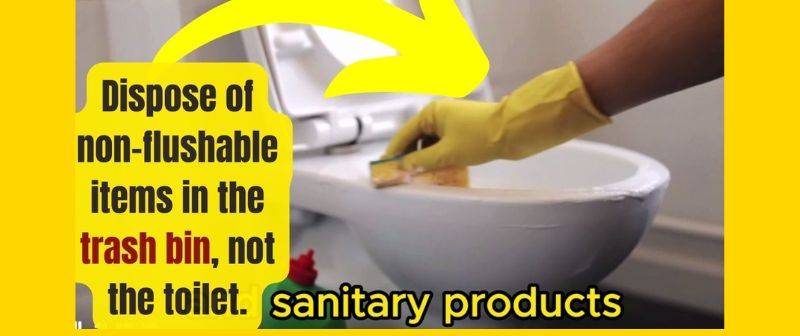If your toilet flushes but the poop stays, it can be a frustrating and unsanitary problem. This issue can be caused by a variety of factors, such as a clogged drain or a faulty flapper valve.
In some cases, the problem may be due to a more serious issue, such as a damaged septic tank or sewer line. In order to fix the problem, it is important to identify the cause and take appropriate steps to resolve it.
This may involve using a plunger or a specialized toilet auger to clear the clog, or it may require calling a plumber for more extensive repairs.
No matter the cause, it is important to address the issue promptly to prevent further issues and maintain a clean and functional bathroom.
Toilet flushes but poop stays
This article will cover more about toilet flushes but the poop stays continue to read and know how to solve it.
How do you get rid of poop stuck in the toilet?

If you have pooped stuck in your toilet, the first step is to try to remove it using a plunger. Place the plunger over the opening at the bottom of the toilet bowl and pump it up and down several times to create suction.
This should help to break up and remove any obstruction in the drain. If this does not work, you may need to use a toilet auger, also known as a plumbing snake.
This tool is a long, flexible rod with a curved end that can be inserted into the drain to clear away any blockages.
To use an auger, insert the end into the drain and carefully push it through the pipe until it reaches the obstruction.
Then, use the handle to twist and turn the auger to break up the clog and remove it from the drain. If these methods do not work, it is best to call a plumber for assistance.
Moreover, you can use hot water, baking soda, and vinegar is all you’ll need. Fill your toilet bowl with baking soda. You can add vinegar a little at a time to prevent overflow. Within a few minutes, the mixture should start bubbling and fizzing.
Why does poop come back after flushing?
There can be several reasons why poop might come back up after being flushed down the toilet. One possibility is that the toilet is clogged and cannot flush properly.
This can be caused by an excessive amount of toilet paper, or by other objects that shouldn’t be flushed down the toilet, such as tampons or wipes.
Another possibility is that there is a problem with the plumbing in your homes, such as a blocked or damaged sewer line.
In some cases, this can cause waste to back up into the toilet and be expelled when you flush. I would recommend checking to see if your toilet is clogged, and if it is, try using a plunger to unclog it.
If the problem persists, you may need to call a plumber to diagnose and fix the problem.
- After flushing blockage
Poop can come back after flushing due to a clog or blockage in the plumbing system. This can be caused by excessive toilet paper, large or non-biodegradable items, or a buildup of grease or other materials in the pipes. In some cases, a faulty flapper or seal in the toilet tank can also cause the issue.
Should you flush the toilet every time you pee?
Yes, it’s generally a good idea to flush the toilet every time you pee. This helps to keep your bathroom clean and prevent any unpleasant smells from developing. Additionally, it’s a common courtesy to flush the toilet for the next person who may use the bathroom after you.
Furthermore, it is recommended to flush the toilet every time you pee in order to maintain good hygiene and prevent any unpleasant odors. Additionally, flushing the toilet can help prevent the spread of germs and keep the bathroom clean.
How to flush floating poop
Floating poop, also known as stools that float, is a common phenomenon that can occur for a variety of reasons. Some of the causes of floating poop include:
Eating a diet that is high in fat and low in fiber, which can cause the stools to be fatty and oily, leading to them floating in the toilet bowl
Constipation can cause stools to be hard and difficult to pass, leading to them floating in the toilet bowl.
Malabsorption is a condition in which the intestines are unable to properly absorb nutrients from food, leading to loose, fatty stools that may float in the toilet bowl
Overconsumption of carbonated beverages can cause gas to build up in the intestines, leading to floating stools
If you are experiencing floating stools on a regular basis, it is important to speak with your doctor to determine the underlying cause. They may recommend dietary changes, medications, or other treatments to help you achieve healthy, regular bowel movements.
To help prevent floating stools, it is important to eat a balanced diet that is rich in fiber and nutrients. This can help to promote regular bowel movements and prevent constipation.
Drinking plenty of water and staying hydrated can also help to prevent floating stools. Additionally, regular exercise can help to support digestive health and promote regular bowel movements.
You can read another article for Best TOTO Neorest Dual Flush Toilet review
Less water in the Toilet Tank

If you notice that there is less water in the toilet tank than usual, there are a few possible reasons for this. One possibility is that there is a leak in the tank or the toilet itself, which is causing the water to drain out.
Another possibility is that the water level in the tank is set too low, or that the float or fill valve is not functioning properly.
In either case, it is best to check the tank for any visible signs of damage or leakage, and to make sure that the water level is set at the proper height.
- Hard Water Build-Up
Hard water is water that contains high levels of minerals, such as calcium and magnesium. These minerals can cause a build-up of deposits on fixtures and appliances over time, resulting in reduced efficiency and potential damage.
Common signs of hard water include spotted or cloudy glassware, soap scum on shower doors and tiles, and a whitish or yellowish film on faucets and drains.
One way to combat hard water is to install a water softener, which removes the minerals that cause hard water. In some cases, it may also be necessary to use special cleaners or descalers to remove existing deposits.
Regular cleaning and maintenance can help prevent future build-up and protect your fixtures and appliances from damage.
- Toilet Flushing “Flushable” Wipes
Although some companies may claim that their “flushable” wipes are safe to use in the toilet, it is generally not recommended to flush them. This is because these wipes do not break down like toilet paper, and can cause clogs in your plumbing and sewage system.
In fact, many municipalities have reported increased plumbing and sewage problems due to the improper disposal of “flushable” wipes.
The best way to dispose of “flushable” wipes is to throw them in the trash. This will prevent them from causing problems in your plumbing and sewage system and will help keep your toilet and pipes functioning properly.
If you do experience a clog due to flushing wipes, it is best to call a plumber for professional assistance.
Which are the Best Tools for a Clogged Toilet?
One of the best tools for a clogged toilet on Amazon is the Korky 99-4A Max Performance Toilet Plunger. It has a powerful, oversized plunger head that is designed to fit most toilet bowls and a flexible, reinforced rubber cup that provides maximum pressure for efficient clog removal.
It also has a large, comfortable handle for easy grip and control. Other popular options on Amazon include the Dynaforce Toilet Plunger and the Cobra Products 20300 Toilet Auger.
Those are several tools that can be effective at unclogging a toilet on Amazon, including a plunger, a plumber’s snake, and a toilet auger. It’s a good idea to try using a plunger first, as this is often the most effective and least expensive option.
Final Word
If your toilet is flushing but the poop is staying, it could be caused by a few different things. The most common cause is a clog in the toilet’s trap or drainpipe. This can be caused by an excess of toilet paper, a foreign object that has been flushed down the toilet, or a buildup of waste material.
Other potential causes could include a faulty flapper valve or a malfunctioning flush handle. To fix the issue, you may need to use a plunger to clear the clog, or you may need to call a plumber for assistance.
is that there is likely a clog in the toilet’s drainage system. It may be necessary to use a plunger or snake to clear the clog and allow the toilet to properly flush.
- 26 Backyard Shower Ideas That Turn Your Outdoor Space Into a Spa - July 11, 2025
- 26 Breathtaking Farmhouse Kitchen Designs to Inspire Your Remodel - July 10, 2025
- 22 Modern Dark Bedroom Aesthetic Ideas You’ll Love and Copy - July 9, 2025

